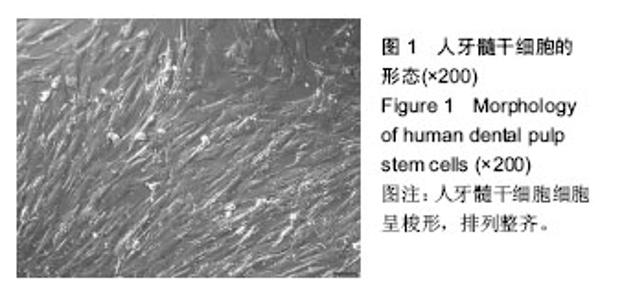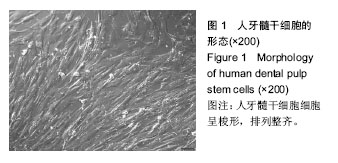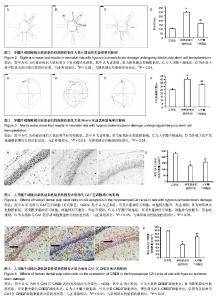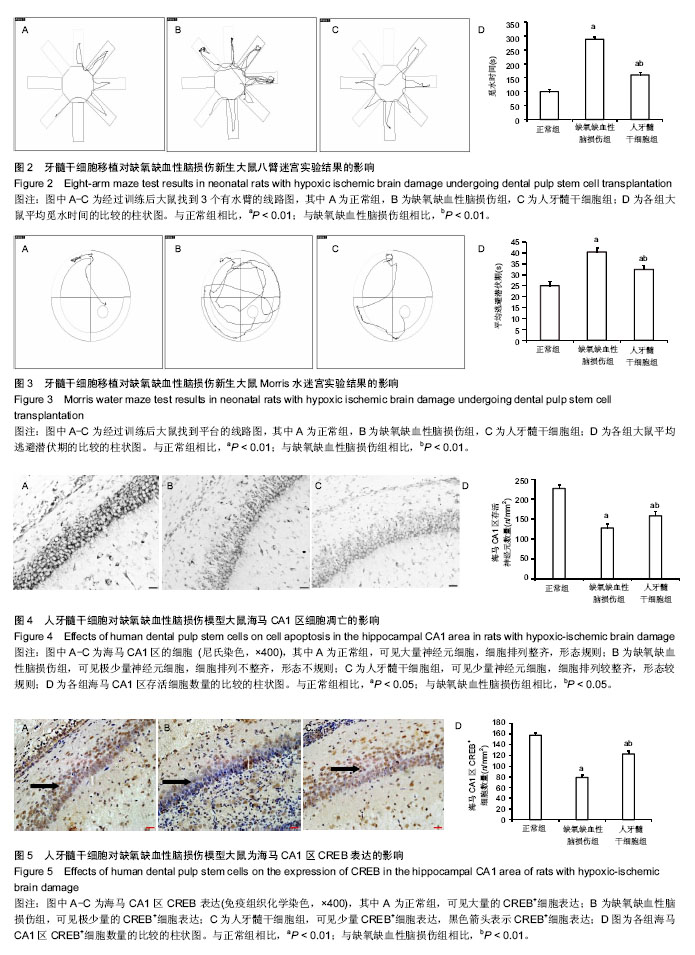| [1] Li Y, Gonzalez P, Zhang L. Fetal stress and programming of hypoxic/ischemic-sensitive phenotype in the neonatal brain: mechanisms and possible interventions. Prog Neurobiol. 2012;98(2):145-165. [2] Wang XL, Zhao YS, Hu MY, et al. Umbilical cord blood cells regulate endogenous neural stem cell proliferation via hedgehog signaling in hypoxic ischemic neonatal rats. Brain Res. 2013;1518:26-35.[3] 马子洋,郭晓霞.牙髓干细胞在再生医学中的应用研究与进展[J].中国组织工程研究,2016,20(19):2872-2878.[4] Matsubara K, Matsushita Y, Sakai K, et al. Secreted ectodomain of sialic acid-binding Ig-like lectin-9 and monocyte chemoattractant protein-1 promote recovery after rat spinal cord injury by altering macrophage polarity. J Neurosci. 2015;35(6):2452-2464.[5] 贺慧霞,金岩,史俊南,等.牙髓干细胞向神经细胞方向的诱导分化实验[J].华西口腔医学杂志,2007,25(4):331-334.[6] Fang CZ, Yang YJ, Wang QH, et al. Intraventricular injection of human dental pulp stem cells improves hypoxic-ischemic brain damage in neonatal rats. PLoS One. 2013;8(6):e66748. [7] Sakai K, Yamamoto A, Matsubara K, et al. Human dental pulp-derived stem cells promote locomotor recovery after complete transection of the rat spinal cord by multiple neuro- regenerative mechanisms. J Clin Invest. 2012;122(1): 80-90. [8] Apel C, Forlenza OV, de Paula VJ, et al. The neuroprotective effect of dental pulp cells in models of Alzheimer's and Parkinson's disease. J Neural Transm (Vienna). 2009;116(1): 71-78.[9] Nakashima M, Iohara K, Sugiyama M. Human dental pulp stem cells with highly angiogenic and neurogenic potential for possible use in pulp regeneration. Cytokine Growth Factor Rev. 2009;20(5-6):435-440. [10] Schmid RS, Graff RD, Schaller MD, et al. NCAM stimulates the Ras-MAPK pathway and CREB phosphorylation in neuronal cells. J Neurobiol. 1999;38(4):542-558.[11] White DM, Walker S, Brenneman DE, et al. CREB contributes to the increased neurite outgrowth of sensory neurons induced by vasoactive intestinal polypeptide and activity-dependent neurotrophic factor. Brain Res. 2000; 868(1):31-38.[12] Tomás Pereira I, Coletta CE, Perez EV, et al. CREB-binding protein levels in the rat hippocampus fail to predict chronological or cognitive aging. Neurobiol Aging. 2013;34(3):832-844.[13] Rice JE 3rd, Vannucci RC, Brierley JB. The influence of immaturity on hypoxic-ischemic brain damage in the rat. Ann Neurol. 1981;9(2):131-141.[14] Gronthos S, Mankani M, Brahim J, et al. Postnatal human dental pulp stem cells (DPSCs) in vitro and in vivo. Proc Natl Acad Sci U S A. 2000;97(25):13625-13630.[15] Hilkens P, Gervois P, Fanton Y, et al. Effect of isolation methodology on stem cell properties and multilineage differentiation potential of human dental pulp stem cells. Cell Tissue Res. 2013;353(1):65-78.[16] 谢岷,杨于嘉,王晓莉,等.骨髓基质细胞移植治疗新生大鼠缺氧缺血性脑损伤时间窗探讨[J].中华儿科杂志,2007,45(5):396-397.[17] 王霞,杨于嘉,贾延劼,等.新生大鼠缺氧缺血性脑损伤神经干细胞移植部位的探讨[J].中华医学杂志,2007,87(12):847-850.[18] Balduini W, De Angelis V, Mazzoni E, et al. Long-lasting behavioral alterations following a hypoxic/ischemic brain injury in neonatal rats. Brain Res. 2000;859(2):318-325.[19] Morris RG. Spatial localization does not require the presence of local cues. Learn Motiv. 1981;12(2):239-260.[20] Yalvac ME, Rizvanov AA, Kilic E, et al. Potential role of dental stem cells in the cellular therapy of cerebral ischemia. Curr Pharm Des. 2009;15(33):3908-3916.[21] Karaöz E, Demircan PC, Sa?lam O, et al. Human dental pulp stem cells demonstrate better neural and epithelial stem cell properties than bone marrow-derived mesenchymal stem cells. Histochem Cell Biol. 2011;136(4):455-473. [22] Ringe J, Kaps C, Schmitt B, et al. Porcine mesenchymal stem cells. Induction of distinct mesenchymal cell lineages. Cell Tissue Res. 2002;307(3):321-327. [23] Mauney JR, Kirker-Head C, Abrahamson L, et al. Matrix- mediated retention of in vitro osteogenic differentiation potential and in vivo bone-forming capacity by human adult bone marrow-derived mesenchymal stem cells during ex vivo expansion. J Biomed Mater Res A. 2006;79(3):464-475.[24] Woods EJ, Perry BC, Hockema JJ, et al. Optimized cryopreservation method for human dental pulp-derived stem cells and their tissues of origin for banking and clinical use. Cryobiology. 2009;59(2):150-157. [25] Hayward P. Presenilin dysfunction leads to memory and plasticity defects. Lancet Neurol. 2004;3(6):327.[26] van den Berg M, Verbaarschot P, Hontelez S, et al. CREB expression in the brains of two closely related parasitic wasp species that differ in long-term memory formation. Insect Mol Biol. 2010;19(3):367-379. [27] Hawk JD, Abel T. The role of NR4A transcription factors in memory formation. Brain Res Bull. 2011;85(1-2):21-29. [28] Han JH, Kushner SA, Yiu AP, et al. Neuronal competition and selection during memory formation. Science. 2007;316(5823): 457-460.[29] Pittenger C, Huang YY, Paletzki RF, et al. Reversible inhibition of CREB/ATF transcription factors in region CA1 of the dorsal hippocampus disrupts hippocampus-dependent spatial memory. Neuron. 2002;34(3):447-462.[30] Hinoi E, Balcar VJ, Kuramoto N, et al. Nuclear transcription factors in the hippocampus. Prog Neurobiol. 2002;68(2): 145-165. |



